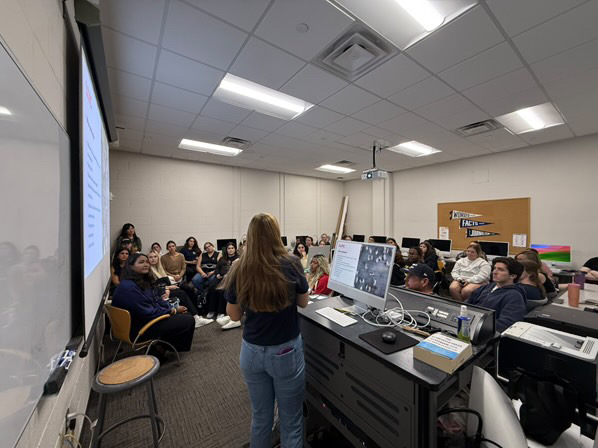Decline in OU Enrollment, expected $17 million deficit
A hot topic that has been brought up — especially with Oakland University professors’ work stoppage last week — is the decline in OU enrollment. With the conflicts of last week, the student body and faculty are wondering where the university stands in terms of finance.
With the Sept. 20 deadline for enrolling, as well as adding and dropping classes, the university has not yet reported official enrollment data for fall of 2021.
“Enrollment across all institution types fell by 2.9% this past winter compared with last winter,” said Vice President of Enrollment Management Dawn Aubry. “This has been the most challenging year for universities across the country, and Michigan is no exception. Many regional universities are reporting reductions in new admissions and returning undergraduate students for the fall 2021 semester.”
This year has been tough on students and their families, and there is a lot that needs to be done to help them, “particularly among first-generation, low-income and underrepresented minorities who are continuing to struggle the most during the pandemic,” according to Aubry.
Aubry also said that for community colleges, the numbers are even more alarming, dropping 11.3% in enrollment over the past year.
As for how much money OU has lost over the past year Aubry said, “Based on data from our finance and administration leaders, we expect there could be a $17 million deficit. They base this estimate on COVID concerns, the lower number of high school graduates and competition among schools. We are hopeful and confident that Oakland University will continue to be the university of choice for transfer students, a traditional strong suit for enrollment.”
So far, there have been no updates on how the two-day strike has impacted student retention, and Aubry said that an important part of keeping students from transferring or dropping out of OU is for staff and faculty to re-engage them.
“Students want and need to feel connected and cared for,” Aubry said. “When OU faculty and staff uphold their responsibility to provide academic, social and emotional support, the consistent and intentional connection with students can support engagement and prevent dropouts.”
Their plan “Grizzlies Together Again” outlines the expectation for the fall semester in order to make campus safe for all students, faculty and staff. That plan includes a daily health screening process, a mask mandate and vaccination requirements.
OU has taken several steps toward recruiting new undergraduate students, including offering test optional admission, instituting scholarships award modifications, virtual orientation programs for the incoming class of 2021 in August and September and in-person campus tours in May.
“OU remains among the lowest-cost universities for entering first-year students,” Aubry said.
Paying for university has been a serious problem throughout the pandemic. The university has distributed $16.2 million in emergency funding that they received through the Coronavirus Aid, Relief and Economic Security (CARES) Act for eligible students to help ease financial strains. There are also special automatic scholarships for transfer students, including the OU Frontline Workers Scholarship.
“We will continue to offer extraordinary support services to all students,”Aubry said.







Anonymous • Sep 16, 2021 at 5:49 PM
The problem is that the administration has been complaining about enrollment declines for well over the last decade. The administration raises this issue every time faculty propose new programs, labs, or anything that would actually improve the educational experience of students.
If the administration truly felt that there would be declines in enrollment, one is forced to ask: Why has the Oakland Center been massively expanded and renovated twice over this past decade? Why build the new Human Health Building or Engineering Center? Why are there endless construction projects on campus if there will be fewer students, and why has none of that construction money been set aside to cushion the impact of any enrollment declines.
Separate, but related to this will be the effect of COVID. But, it is worth remembering
1) Michigan Reconnect will now allow adults over 25 years old to go to community college for free, and some of those students will almost certainly continue their education at OU;
2) CNBC reported that 25% of students delayed going to college because of the pandemic. Presumably, some of those students will enroll now that we’re back to in person learning;
3) The State of Michigan has added an additional 2% to the budget for all state universities for the 2021-2022 Fiscal Year, so Oakland University will see an additional million dollars, on top of funds they already receive;
4) The Higher Education Emergency Relief program allows the university to apply for federal funding to help respond to COVID losses. Valid reasons to apply include enrollment declines, unpaid student debts, and decline in research funding obtained by faculty;
5) The university recently spent hundreds of thousands of dollars on a Chief Operating Officer that nobody could explain the function of, other than to reward a former member of the Board of Trustees; and we have more Vice Presidents that Michigan State, a school with twice as many students. We are significantly top heavy in administrators that serve little function.
Recently, the Detroit Free Press reported on how the pandemic affected the budgets of universities over the past, pandemic year. Oakland University fared FAR better than any other university. While tuition revenue fell by a little more than 4%, the overall operating revenue fell by only about 0.5%.
The university has an endowment, alternative non-tuition sources of income, and an Alumni Association that cares a lot. Please do not let the administration tell you students that there is no money to be had to offer you the kind of education you deserve.
Shawna • Sep 16, 2021 at 1:09 PM
The strike has had a little effect on enrollment decline, but realistically both the decline and the strike are symptoms of the same illness. That illness is the focus of all higher education institutions on profit over education.
Financial analysts across the world have been pointing out for years, decades in fact, that the model currently employed is not sustainable, which has only encouraged those running these institutions to abandon long term investments in education in favor of short term profits for themselves. Take what you can, and leave the mess for the next guy. This is why educational cornerstone departments like Philosophy and History, which teach people how to think properly and how to avoid repeating past mistakes, are given minimal funding while more immediately profitable extra-curriculars like athletics are given as much money as is obtainable. It is also why college administrators salaries are in the 6 digit range while college professors often have to have second jobs to support themselves. Not to mention the debt that students need to incur for their stripped-down educations.
OU is not alone or unusual in this. It is a systemic problem. One which has no future. If our board is interested in demonstrating true leadership for students, if they are at all willing to live up to the claimed purpose of this institution, they will set this dysfunctional model aside, rededicate themselves to education, to their students and to the future, eschew greed, and reform this University from the top down.
If not, then there is nothing to do but expect these symptoms to get worse until the end.